Are you struggling with backlink monitor tools and remain unsure why you should use them? A backlink monitoring tool is a crucial tool for link building in SEO because it helps you monitor your website’s backlink profile, letting you know the quality of the backlinks, anchor text, and more.
Apart from that, you can also use the link monitoring tool to identify your competitor’s backlink profile to find opportunities to acquire backlinks from the websites that link to your competitor’s website by identifying prospects and conducting link-building outreach.
In this article, we’ll share the importance of backlink monitoring tools, why you should use them, and the best backlink monitoring tools you should try.
Are you ready to go? Let’s get started.
The Importance of Backlink Monitoring
Links remain a crucial factor in SEO for helping content ranking. Apart from these, links also guide search engines to discover, crawl, and index content, acting as a roadmap for search engine crawlers.
They also serve as a signal of the page’s authority and relevancy, with more quality links pointing to a page suggesting it is a valuable and trustworthy resource. This helps determine a page’s ranking in search engine results pages (SERPs).
However, links aren’t built with the same value as search engines evolve quality over quantity, acquire links from reputable resources to help you build authority, and enhance your website ranking in SERPs.
Benefits of Monitoring Backlinks (Why Use the Backlink Monitor Tool?)
Backlink monitoring tools offer numerous benefits to your link-building efforts, from monitoring your backlink profile to developing an effective link-building plan.
You use a backlink monitor tool to maintain your website’s authority and search rankings by automatically tracking new, lost, and harmful backlinks, assessing link quality, and providing alerts for potential issues.
This proactive approach helps protect your site from penalties, improve user experience, and gain insights into your competitors’ link-building strategies.
1. How to Identify New Backlinks
To identify new backlinks, you can use tools like Google Search Console, Ahrefs, and Semrush to monitor your website’s backlink profile and analyze competitors’ backlinks.
Regularly checking your site’s link growth with Google Search Console’s “Links” tab and specialized SEO platforms allows you to track incoming links.
You can also conduct competitive backlink analysis to find opportunities and apply strategies like broken link building or creating high-quality content to earn new links.
Here’s how to identify new backlinks with Ahrefs
To identify new backlinks, you can use Ahrefs’ free backlink checker by entering your domain and clicking on the “Check backlinks” button, then Ahrefs pops up the backlink data of sites from which your website has received the links.
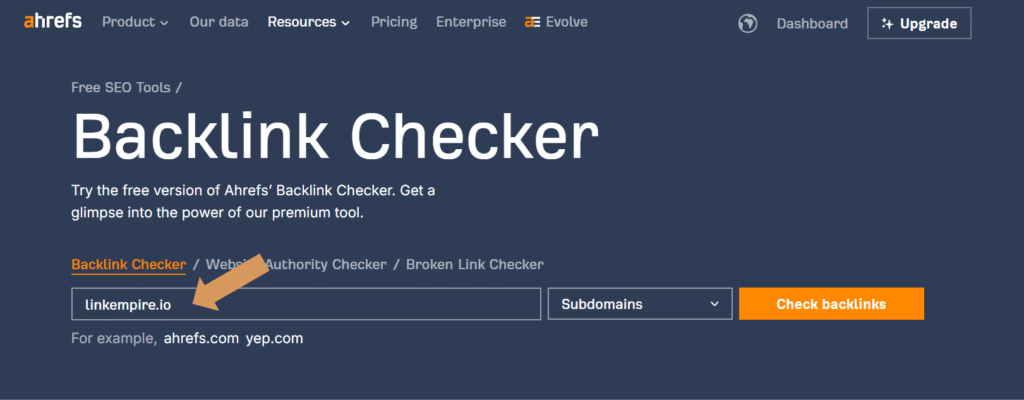
Another option is to monitor your backlinks profile with Ahrefs by signing up for a free account, creating a project, and importing your website data from Google Search Console.
2. Detecting lost backlinks
Lost link detection refers to identifying when a previously existing hyperlink is no longer functional, often seen as a “broken link” or a “404 error”. Backlink monitoring tools usually come with a link loss detection feature to report on the removed links.
The feature is really useful when it comes to backlink management and link loss recovery strategy development.
In the Ahrefs Backlink tool, you have the option to monitor the lost links. By entering the lost links feature, the tool will report all the removed links if the previously existing hyperlink is no longer available.
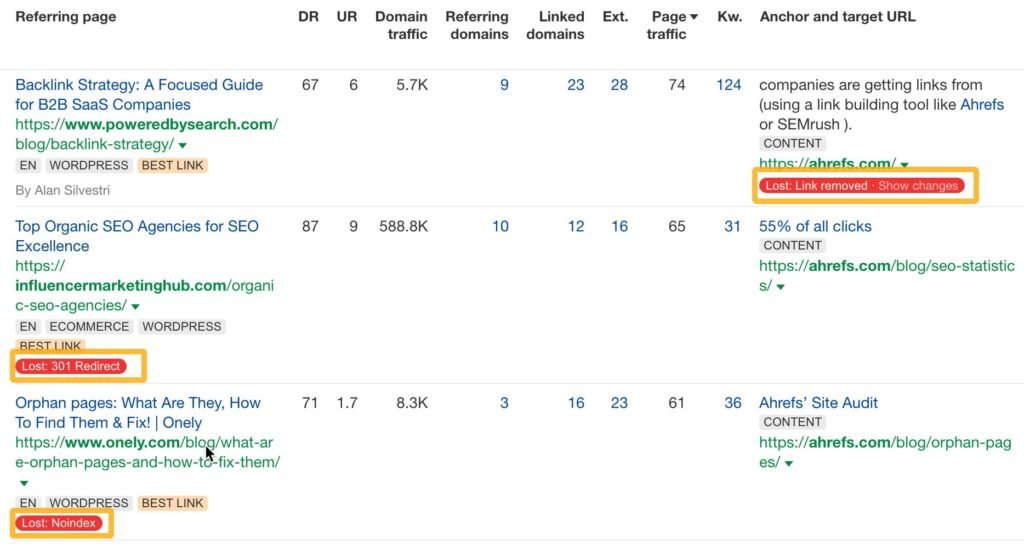
3. Analyzing competitor backlinks
Competitor backlink analysis is an SEO tactic that involves examining your competitors’ backlinks to uncover linking opportunities, identify their link-building strategies, and ultimately improve your website’s search engine rankings and drive more traffic.
By “reverse-engineering” a competitor’s backlinks, you can learn which websites are linking to them and leverage this information to build a superior backlink profile for your own site.
No matter what industry you’re in. Backlink monitoring tools help you pull out competitors’ backlink profiles to find link prospects and strategy development for your link-building outreach campaign.
4. How to find Competitor’s Backlinks
A quick and easy way to find your competitor’s backlinks is by visiting a free tool like Ahrefs’ free backlink checker or SEMrush’s Backlink Analytics.
Entering the competitor domain and clicking on the “Check Backlinks” button, the tool will pull all of your competitor’s backlinks from its database and provide you with an exportable report, which you can download as a PDF or CSV file.
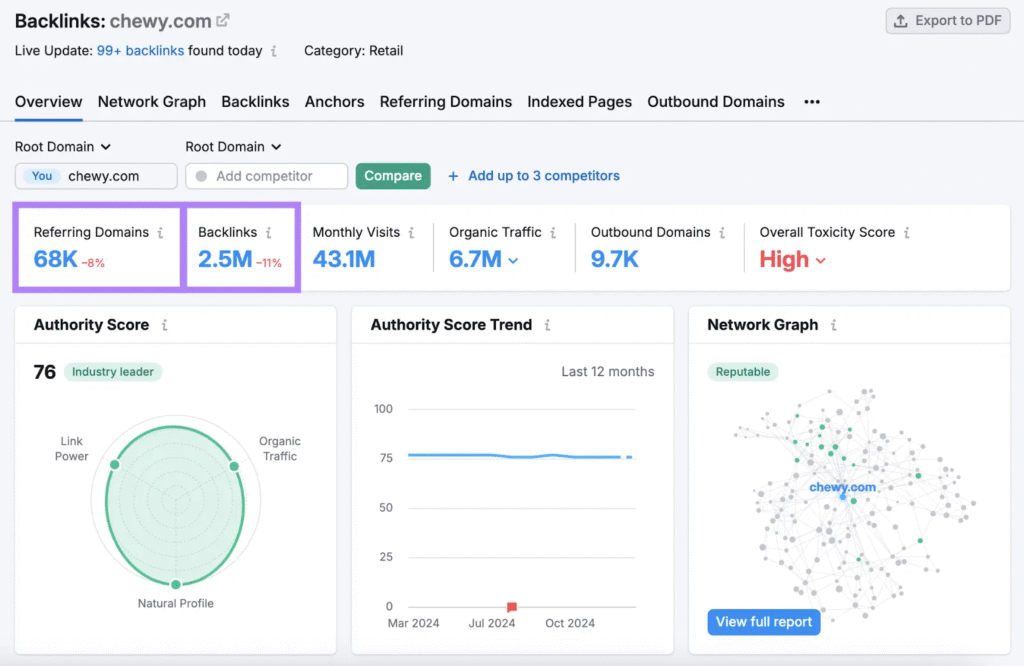
Top 5 Backlink Monitor Tools
There are so many backlink monitoring tools available in the industry. But in today’s article, I only picked the top 5 most popular link-building tools you can use to monitor your backlink profile, develop a link-building strategy, track competitors, find link opportunities, and more.
Tool #1: Ahrefs

Ahrefs is one of the most popular SEO tools in the industry, known for its massive backlink database and highly accurate data. It’s widely used by SEO professionals to analyze link profiles, track competitors, and identify link-building opportunities
1. Features and Functionalities
- Massive backlink index with billions of live links.
- Detailed backlink profile, including referring domains, anchor texts, and new vs. lost links.
- Domain Rating (DR) and URL Rating (UR) are used to measure link authority.
- Alerts for newly gained or lost backlinks.
- Competitor backlink analysis.
2. How to Use Ahrefs for Backlink Monitoring
- Enter your domain in the Site Explorer tool.
- Navigate to the Backlinks tab to see all referring domains and links.
Use filters to identify dofollow vs. nofollow links. - Set up Alerts to receive notifications when you gain or lose backlinks.
- Compare your backlink profile with competitors to find link-building opportunities.
Tool #2: SEMrush

SEMrush is a powerful all-in-one SEO suite that goes beyond backlink analysis. With its extensive backlink analytics and auditing features, it helps users identify both valuable and harmful links, making it ideal for ongoing backlink health monitoring.
1. Features and Functionalities
- Extensive backlink database with frequent updates.
- Backlink Authority Score for evaluating link quality.
- The Toxic Score feature is used to detect harmful backlinks.
- Historical data to track backlink growth trends.
- Competitor gap analysis to uncover linking opportunities.
2. How to Use SEMrush for Backlink Monitoring
- Open the Backlink Analytics tool and enter your website URL.
- Review your backlink profile, referring domains, and anchor texts.
- Use the Backlink Audit feature to identify and disavow harmful links.
- Compare multiple domains to analyze competitor link strategies.
- Schedule automatic reports to track backlink performance over time.
Tool #3: Moz Link Explore
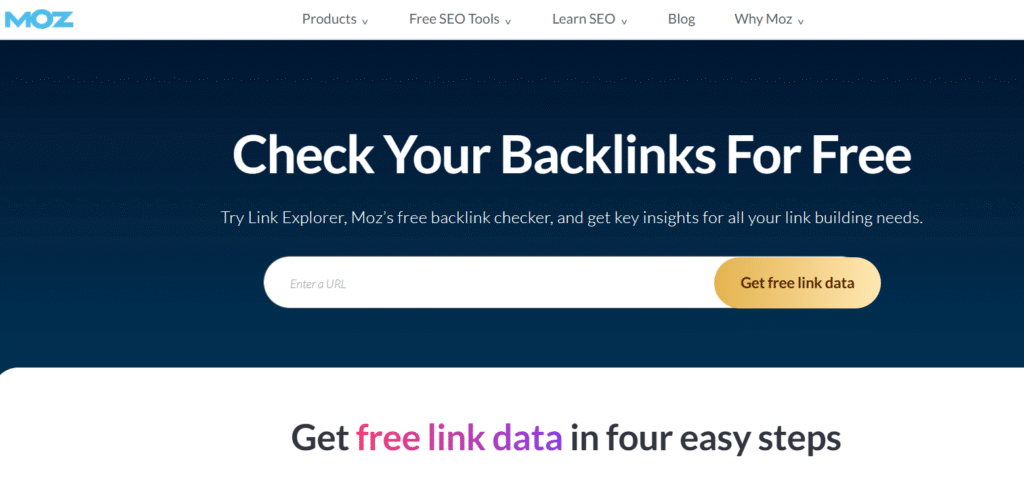
Moz Link Explorer is a trusted tool that focuses on backlink insights, authority metrics, and spam detection. It’s particularly useful for understanding the quality of inbound links and evaluating the overall authority of a domain.
1. Features and Functionalities
- Tracks inbound links, referring domains, and anchor text distribution.
- Provides Domain Authority (DA) and Page Authority (PA) metrics.
- Spam Score to detect potentially harmful backlinks.
- Competitor backlink comparison.
- Historical data for monitoring link growth.
2. How to Use Moz Link Explorer for Backlink Monitoring
- Log in to Moz and access the Link Explorer tool.
- Enter your domain to check backlinks and referring domains.
- Use the Inbound Links tab to view high-quality vs. low-quality links.
- Monitor changes in DA/PA to measure the impact of backlinks.
- Set up ongoing link tracking for key competitor websites.
Tool #4: Majestic

Majestic specializes in backlink analysis and is well-regarded for its proprietary metrics—Trust Flow and Citation Flow. These help SEO professionals measure the quality and quantity of backlinks, making it one of the most detailed tools for backlink monitoring.
1. Features and Functionalities
- Proprietary metrics: Trust Flow (TF) and Citation Flow (CF) for backlink quality evaluation.
- Detailed link context showing how and where links appear.
- Historic Index for long-term backlink tracking.
- Topical Trust Flow to categorize links by niche relevance.
- Bulk backlink analysis for multiple sites.
2. How to Use Majestic for Backlink Monitoring
- Enter your site in the Site Explorer tool.
- Analyze Trust Flow vs. Citation Flow to determine link quality.
- Use the Backlink History feature to track link growth over time.
- Check Topical Trust Flow to ensure backlinks align with your industry.
- Export data for bulk analysis and reporting.
Tool #5: Monitor Backlinks
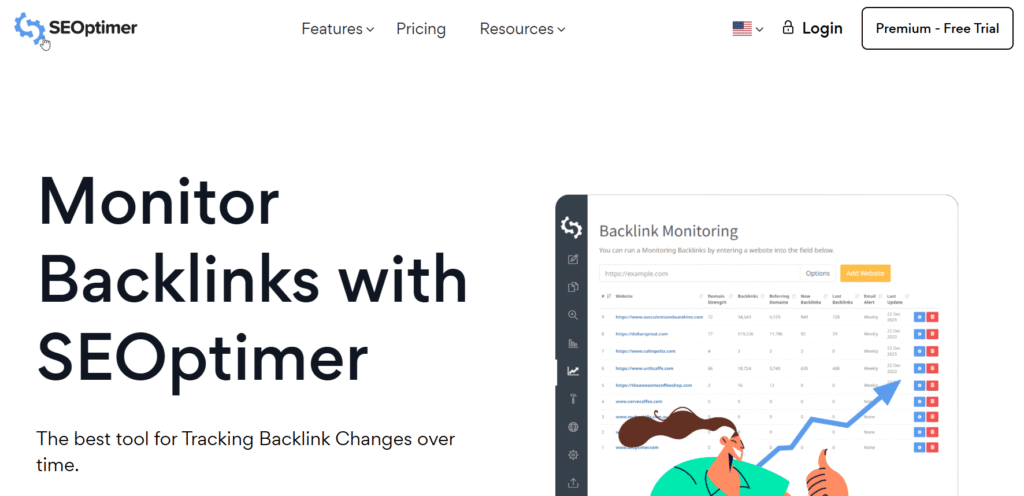
1. Features and Functionalities
- Easy-to-use interface ideal for beginners.
- Automated tracking of new and lost backlinks.
- Alerts for status changes in links (nofollow, broken, removed).
- Integration with Google Analytics for traffic insights.
- Competitor backlink tracking.
2. How to Use Monitor Backlinks for Backlink Monitoring
- Add your domain and connect it with Google Analytics.
- Monitor new, lost, and changed backlinks directly from the dashboard.
- Receive email alerts when backlinks are removed or turn toxic.
- Use competitor tracking to spot new link-building opportunities.
- Export reports to share with clients or team members.
How to Choose the Right Backlink Monitor Tool
To choose the right backlink monitor, assess your budget and business size, identify key features like competitor analysis or toxic link detection, consider data accuracy and index size, and look for tools with user-friendly interfaces and white-label reporting if needed.
Start with free tools like Google Search Console for basic needs, then explore paid options such as Ahrefs, Semrush, or SE Ranking as your requirements grow.
According to a study, 55.5% of link builders use Ahrefs for backlink monitoring, analysis, and strategy development, while the other 14.3% of link builders prefer SEMrush for their link-building efforts. Which means the Ahrefs tool is the most popular in the industry compared to other backlink monitoring platforms.
Conclusion
Backlink monitoring is a crucial element of SEO, and it helps you maintain a clean, authoritative, and competitive link profile. By tracking new, lost, and toxic backlinks, keep yourself away from ranking drops and ensure consistent organic growth.
In this article, we explored the top 5 backlink monitoring tools, such as Ahrefs, SEMrush, Moz Link Explorer, Majestic, and Monitor Backlinks. Each of them offers unique advantages, whether you’re looking for advanced data analysis, competitor research, or a beginner-friendly dashboard.
To stay ahead in SEO, it’s not enough to build backlinks—you must also monitor and manage them effectively. Start using one of these tools today to strengthen your link-building strategy, boost your rankings, and achieve long-term success in search engines.
Share via:

